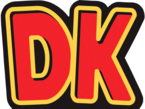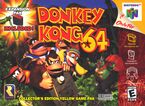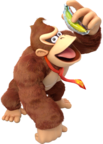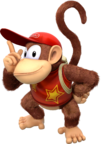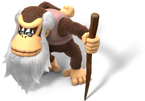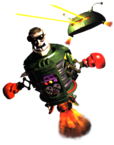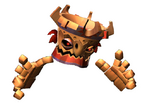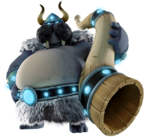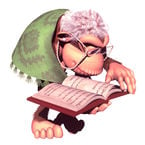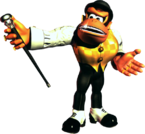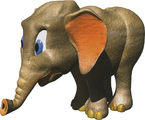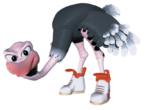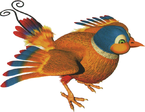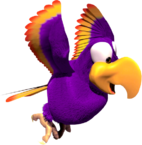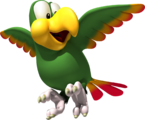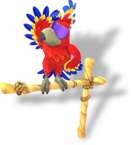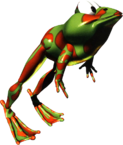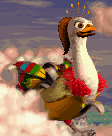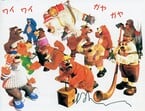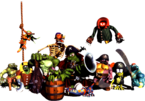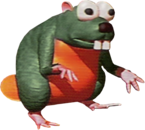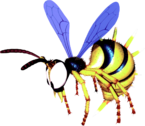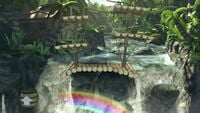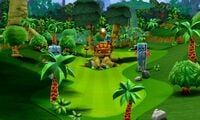Donkey Kong Country (series): Difference between revisions
No edit summary Tags: Mobile edit Advanced mobile edit |
Tags: Mobile edit Advanced mobile edit |
||
| Line 101: | Line 101: | ||
|} | |} | ||
==Flash games== | ===Flash games=== | ||
{|align=center width=100% class="wikitable" | {|align=center width=100% class="wikitable" | ||
|- | |- | ||
Revision as of 10:33, September 14, 2024
- This article is about the video game series. For the cartoon, see Donkey Kong Country (television series).
| Donkey Kong Country | |
|---|---|
 The logo used for the original three installments in the series  The logo used for Donkey Kong Country Returns  The logo used for Donkey Kong Country: Tropical Freeze | |
| First installment | Donkey Kong Country (1994) |
| Latest installment | Donkey Kong Country: Tropical Freeze (Nintendo Switch) (2018) |
| Number of installments | 13 (5 main, 6 reissues, 1 Flash, 1 canceled, 1 upcoming reissue) |
| Franchise | Donkey Kong |
| Key staff | Tim Stamper, Gregg Mayles, Chris Sutherland, David Wise, Leigh Loveday |
The Donkey Kong Country series is a video game series in the Donkey Kong franchise. Although it usually stars Donkey Kong and his sidekick, Diddy Kong, Donkey Kong also ends up kidnapped in several games. The series is a platformer series. The series was started and produced by Rare, until they were bought by Microsoft. Remakes are included in the Game Boy Color, Game Boy Advance, and Nintendo 3DS handhelds. The series was later revived by Retro Studios and their game, Donkey Kong Country Returns. The Donkey Kong Country series also has well-received reviews and has greatly impacted future titles.
The Donkey Kong Country series is also the inspiration for a very similar series created for the Game Boy system, known as the Donkey Kong Land series.
List of games in the series
Original titles
| Title | |
|---|---|
| Cover, original release, and system | Plot synopsis |
| Donkey Kong Country | |
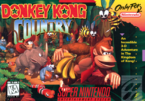 Template:ReleaseSNES |
The series' first game is Donkey Kong Country. It was released for the Super Nintendo Entertainment System in 1994 and is known for being the first game to use pre-rendered sprites, creating a 3D-CG effect throughout the game. Here, Donkey Kong is different from his appearances in previous, due to the new Donkey Kong being the grandson of the original, who is older and is now named Cranky Kong. In this game, the Kremlings steal his banana hoard. Donkey Kong takes his sidekick Diddy Kong to stop King K. Rool and get his bananas back.
The game has been released for Wii, Wii U, and New Nintendo 3DS through Virtual Console. It is also included in the Super NES Classic Edition, and was added to Super Nintendo Entertainment System - Nintendo Switch Online in 2020. |
| Donkey Kong Country 2: Diddy's Kong Quest | |
 Template:ReleaseSNES |
Donkey Kong Country's sequel Donkey Kong Country 2: Diddy's Kong Quest was released for the Super Nintendo Entertainment System in 1995. In this game, Donkey Kong has been kidnapped by King K. Rool who is the alias Kaptain K. Rool. Diddy Kong takes his partner, Dixie Kong to save Donkey Kong from Kaptain K. Rool. The game plays similarly to Donkey Kong Country, and has new gameplay elements, enemies, and obstacles added.
The game has been released for Wii, Wii U, and New Nintendo 3DS through Virtual Console. It was also added to Super Nintendo Entertainment System - Nintendo Switch Online in 2020. |
| Donkey Kong Country 3: Dixie Kong's Double Trouble! | |
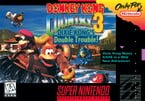 Template:ReleaseSNES |
The third game in the series is Donkey Kong Country 3: Dixie Kong's Double Trouble!, released for the Super Nintendo Entertainment System in 1996. In this game, Donkey Kong and Diddy Kong both are captured by KAOS, a new leader from the Kremling Krew. Dixie Kong takes her cousin Kiddy Kong with her and sets out to save Donkey Kong and Diddy Kong from KAOS. KAOS is revealed to be a puppet of King K. Rool who is under the alias Baron K. Roolenstein. The game plays similarly to the former two games but has a large amount of new elements.
The game has been released for Wii, Wii U, and New Nintendo 3DS through Virtual Console. It was also added to Super Nintendo Entertainment System - Nintendo Switch Online in 2020. |
| Donkey Kong Country Returns | |
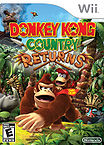 Template:ReleaseWii |
Donkey Kong Country Returns is a revival of the series, released in 2010. It is a 2.5D side-scrolling Wii developed by Retro Studios after a hiatus (excluding remakes) of over a decade. The game has new villains, called the Tikis, who raid Donkey Kong's banana stash. Donkey Kong and Diddy Kong set out to retrieve the lost bananas due to this. Cranky Kong also makes an appearance as the shopkeeper. This is the first Donkey Kong Country series game to not feature Kremlings or underwater levels.
The game was released for Wii U via Virtual Console in 2015. |
| Donkey Kong Country: Tropical Freeze | |
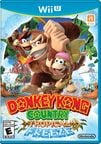 Template:ReleaseWii U |
Donkey Kong Country: Tropical Freeze is a game developed by Retro Studios for the Wii U, released in 2014. Donkey Kong and Diddy Kong reappear, and Dixie Kong, and Cranky Kong are playable characters with a similar role to Diddy Kong in Donkey Kong Country Returns. Funky Kong also makes an appearance as the shopkeeper. The game's antagonists, the Snowmads, freeze Donkey Kong Island. During the game, the Kongs try to defeat the Snowmads to restore the island back to its initial state. |
Reissues
| Title | |
|---|---|
| Cover, original release, and system | Synopsis |
| Donkey Kong Country (Game Boy Color) | |
 Template:ReleaseGame Boy Color |
Donkey Kong Country was ported to the Game Boy Color in 2000. Several significant differences were made such as having only one Kong appear at a time, extended and exclusive levels, new minigames, and more. This was the only game in the series to be ported to the Game Boy Color. |
| Donkey Kong Country (Game Boy Advance) | |
 Template:ReleaseGame Boy Advance |
Donkey Kong Country was remade for the Game Boy Advance in 2003, as the original code had been lost,[1] requiring recoding from scratch and ripping of graphics from the SNES version using emulators. This remake features new changes to the game not in the Game Boy Color port. Changes include bosses made more challenging, redesigned graphics, replaced order of levels, new modes, a scrapbook, and more. |
| Donkey Kong Country 2 (Game Boy Advance) | |
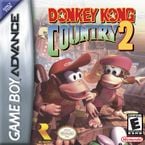 Template:ReleaseGame Boy Advance |
Donkey Kong Country 2: Diddy's Kong Quest was remade for the Game Boy Advance in 2004 in the same way as the previous game. The title was shortened to Donkey Kong Country 2, and features significant changes such as a new boss, graphical makeovers, more DK Coins to collect, and altered and replaced levels. |
| Donkey Kong Country 3 (Game Boy Advance) | |
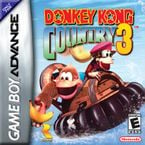 Template:ReleaseGame Boy Advance |
Donkey Kong Country 3: Dixie Kong's Double Trouble! was remade for the Game Boy Advance in 2005. Like the previous remakes, major changes has been added. These changes include graphical makeovers, exclusive boss fights, a new soundtrack, and new and different methods of trading items and new areas, including the new world Pacifica. |
| Donkey Kong Country Returns 3D | |
 Template:ReleaseNintendo 3DS |
Donkey Kong Country Returns was ported to the Nintendo 3DS in 2013, titled Donkey Kong Country Returns 3D. The remake has additional new content. This includes New Mode (which includes additional items in Cranky Kong's Shop and a third heart added to the life meter), and a new world called Cloud, which features additional levels that are not present in the Wii game. |
| Donkey Kong Country: Tropical Freeze (Nintendo Switch) | |
 Template:ReleaseNintendo Switch |
Donkey Kong Country: Tropical Freeze was ported to the Nintendo Switch in 2018, adding a new easier mode where Funky Kong is playable for the first time in the series. |
| Donkey Kong Country Returns HD | |
 Template:ReleaseNintendo Switch |
Donkey Kong Country Returns will be remastered for the Nintendo Switch in 2025, titled Donkey Kong Country Returns HD, updating the graphics from the Wii and 3DS versions. |
Flash games
| Title | |||||||||||||||||||||||||||||||||||||||||||||||||||||||||||||||||||||||||||||||||||||||||||||||||||||
|---|---|---|---|---|---|---|---|---|---|---|---|---|---|---|---|---|---|---|---|---|---|---|---|---|---|---|---|---|---|---|---|---|---|---|---|---|---|---|---|---|---|---|---|---|---|---|---|---|---|---|---|---|---|---|---|---|---|---|---|---|---|---|---|---|---|---|---|---|---|---|---|---|---|---|---|---|---|---|---|---|---|---|---|---|---|---|---|---|---|---|---|---|---|---|---|---|---|---|---|---|---|
| Title screen, original release, and system | Synopsis | ||||||||||||||||||||||||||||||||||||||||||||||||||||||||||||||||||||||||||||||||||||||||||||||||||||
| Barrel-Blastapalooza | |||||||||||||||||||||||||||||||||||||||||||||||||||||||||||||||||||||||||||||||||||||||||||||||||||||
 2005 Adobe Flash |
DKC 3 -- Barrel-Blastapalooza was an online Flash advergame hosted on the now defunct Donkey Kong Country official website,[2] as well as in the Nintendo Arcade section of nintendo.com.[3] It promoted the Game Boy Advance release of Donkey Kong Country 3.
PitchesDonkey Kong Country 4According to Rare employee Paul Rahme, it was internally suggested at Rare to make a Donkey Kong Country sequel on the Nintendo DS, as remaking the trilogy for the Game Boy Advance gave the developers experience and a good basis for making a sequel.[4][1] Related series
GameplayThe Donkey Kong Country games are sidescrolling platformers. The player plays the role of two Kongs, who must reach the end of each level while avoiding enemies and obstacles. The player can collect Bananas and Extra Life Balloons to gain extra lives. Various types of Barrels are present throughout the levels, which can be used to defeat enemies, reveal hidden passages, or traverse through levels. Animal Friends often appear throughout the levels, which can assist the player, be ridden, and transformed into by the player. The Donkey Kong Country games are divided into worlds, all containing a variable number of levels, friendly Kongs who provide services such as saving, tips and minigames, and a boss battle that marks the end of the world. Worlds tend to be linear, although Donkey Kong Country 3's map allows for a limited degree of exploration. In the original trilogy of games, the player can switch between two Kongs, and use a team up move in the latter two games. In all three games both Kongs act differently, are sometimes required to reach certain areas. If the player takes damage, the Kong that they are playing as runs off the screen and the player is required to use the other Kong until they get them back, usually with a DK Barrel. With one Kong the player cannot use a team up move. If the player takes damage with one Kong, they lose a life. In the games developed by Retro Studios, rather than being fully-featured playable characters, the Kongs besides Donkey Kong acts as powerups expanding Donkey Kong's health and moveset, although they are fully playable in multiplayer and Tropical Freeze's Hard Mode. When the player loses the health gained by the additional Kong, the player loses the Kong. While the original trilogy only allowed the player characters to take one hit in a deliberate effort to reduce clutter[5] on the screen, Donkey Kong can now take multiple hits, with a visible indicator showing his remaining health. In a certain level, vehicles are used. In all games in the series, the player can ride on Mine Carts, Roller Coasters, or Toboggans. These automatically move through a stage and depending on the game and level the player can either jump out of the vehicle or make the vehicle jump. Toboggans can also jump on Buzzes and latch onto railings. In Donkey Kong Country Returns, Mine Cart which the player can only jump out of having crystals in them. In Donkey Kong Country: Tropical Freeze, the player can switch tracks in a third-person view in the level High Tide Ride. In Donkey Kong Country 3: Dixie Kong's Double Trouble, a Rocket Barrel appears in the level Rocket Rush. The player controls the Rocket Barrel by moving left and right and exhausting fuel, which they can restore with Fuel Drums. The Rocket Barrel goes upward at the end of the level. Depending on the version of the game the Rocket Barrel can defeat different types of Buzzes. Rocket Barrels reappear in Donkey Kong Country Returns and Donkey Kong Country: Tropical Freeze, where they automatically move right, do not use fuel and can be moved up or down. At a certain level in Donkey Kong Country Returns, Rocket Barrels automatically move up and can be moved left and right. In Donkey Kong Country: Tropical Freeze, the Log Canoe appears which automatically moves right, can jump, and can sink into the water after jumping. The player can defeat enemies while jumping using the Log Canoe. The Donkey Kong Country series features an emphasis on item collection and exploration. Four KONG Letters appear in each stage giving the player an extra life if they collect all four. The original Donkey Kong Country encourages players to find all of the game's hidden Bonus Areas, with 100% completion slightly changing the dialogue in the ending sequence. Bonus Areas are found usually by breaking a wall or going inside a hidden Barrel Cannon. Each Bonus Area contains a room with a minigame or platforming room. Donkey Kong Country 2 added Kremkoins which are rewards for beating each Bonus Room's objective, and DK Coins which are hidden in each level and are rewards for the Bonus Rooms in the Lost World, which is a new post-completion world with a final boss battle, which can only be accessed by finding and successfully completing the game's bonus areas. Donkey Kong Country 3 features a similar hidden world and again expands the mechanic by featuring another item collection sidequest that extends beyond the game's bonus world. The games developed by Retro Studios include Puzzle Pieces, which replace Kremkoins as the reward for beating Bonus Rooms, and also are collectibles in the main parts of stages. They give access to pictures. In these games, KONG Letters give access to secret levels once all KONG Letters in a world are completed. GraphicsThe first Donkey Kong Country is famed for its usage of pre-rendered 3D sprites, which were rendered on then-cutting edge Silicon Graphics workstation. Although not the first game to use these graphics (the Sharp X68000 version of Ys and Viewpoint feature similar pre-rendered sprites, and predate Donkey Kong Country by several years), Donkey Kong Country was the first mainstream game to be extensively marketed around its pre-rendered graphics, with commercials for the game playing up that the SNES was able to output a game of its visual fidelity without any add-ons,[6] mocking the Sega Genesis. The rendered 3D model of Donkey Kong would serve as the basis for all of his subsequent appearances, with all subsequent games featuring him up until Microsoft's acquisition crediting Rare for providing the model. The Retro Studios installments use rendered-on-the-fly 3D models. In an interview, it was noted that Donkey Kong Country Returns's levels featured three times as many polygons as a room in the studio's previous game, Metroid Prime 3: Corruption.[7] Major charactersProtagonists
Antagonists
Supporting charactersKong Family
Animal Friends
Others
Enemies
Reception
The Donkey Kong Country series has received critical acclaim. On GameRankings, every game in the series have scored 78.61% to 87.87%. On Metacritic, the series' games that were reviewed received 77% to 90%. Donkey Kong Country: Tropical Freeze, was nominated for several awards by news sites such as IGN[8] and Gamespot.[9] The game Jet Kave Adventures was influenced by Donkey Kong Country: Tropical Freeze.[10] Appearances in other seriesSeveral characters from the Donkey Kong Country series and locations based on the series have appeared in other series. In the Mario Tennis series, several courts based off the Donkey Kong Country games appeared. In Mario Tennis, the Donkey Kong Court appears which is set in a jungle with barrels in the background. In Mario Tennis for the Game Boy Color, the Jungle Court appears. In Mario Power Tennis, the DK Jungle Court appears which contains Klaptraps and Kritters. In Mario Tennis Open, the DK Jungle appears. This court takes place in a jungle, and the banana hoard and DK's Tree House appear in the background. The court's music is an arrangement of "DK Island Swing". File:MK8-Course-3DS DKJungle.png The DK Jungle track in Mario Kart 8 Several tracks based on the Donkey Kong Country series appear in the Mario Kart series. In Mario Kart 64 and Mario Kart Wii, DK's Jungle Parkway appears which resembles the jungles in the Donkey Kong Country series. In Mario Kart Arcade GP and Mario Kart Arcade GP 2, the DK Cup appears which contains DK Jungle and Bananan Ruins, which are both based off locations from the Donkey Kong Country series. In Mario Kart Arcade GP DX, this cup reappears with the tracks Bananan Labyrinth and DK Jungle. In Mario Kart 7 and Mario Kart 8, the course DK Jungle appears, which is based off Donkey Kong Country Returns. In the background DK's Tree House appears, part of the track takes place inside the Golden Temple, and several enemies from Donkey Kong Country Returns appear on the track, such as Frogoons and Tiki Goons. The course's music is a rearrangement of DK Island Swing. Several stages based on the series appear in the Super Smash Bros. series. In Super Smash Bros., Super Smash Bros. Melee, Super Smash Bros. for Wii U, and Super Smash Bros. Ultimate, the stage Kongo Jungle appears. This stage takes place in a jungle from Donkey Kong Country, and has a Barrel Cannon under the stage. In Super Smash Bros. Melee, Super Smash Bros. Brawl, Super Smash Bros. for Nintendo 3DS, and Super Smash Bros. Ultimate, the stage Jungle Japes appears where Cranky Kong can be seen in the background and Klaptraps are stage hazards. In Super Smash Bros. Melee and Super Smash Bros. Ultimate, the stage Kongo Falls appears. This stage contains Klaptraps, a Barrel Cannon. DK's Tree House can be seen in the background. Several themes and characters from the Donkey Kong Country series appear in the Super Smash Bros. series a piece of music or trophies. In Super Smash Bros. for Wii U, the stage Jungle Hijinks appears which is based on the level with the same name in Donkey Kong Country Returns. On the stage, the player can travel between the foreground and background layer with Barrels Cannons. Screaming Pillars appear on this stage. The Mario Golf series contains two courses based on the Donkey Kong Country series. In Mario Golf: Toadstool Tour, Congo Canopy appears which contains DK Barrels at the start of each hole. In Mario Golf: World Tour the course DK Jungle appears which is based on Donkey Kong Country Returns. DK's Tree House, Screaming Pillars, Chomps, Barrel Cannons, and TNT Barrels appear on this course. Trivia
References
|
||||||||||||||||||||||||||||||||||||||||||||||||||||||||||||||||||||||||||||||||||||||||||||||||||||

